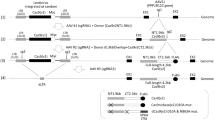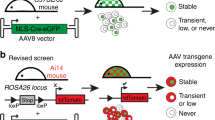Abstract
Stable transduction of mammalian cells typically involves random integration of viral vectors by non-homologous recombination. Here we report that vectors based on adeno-associated virus (AAV) can efficiently modify homologous human chromosomal target sequences. Both integrated neomycin phosphotransferase genes and the hypoxanthine phosphoribosyltransferase gene were targeted by AAV vectors. Site-specific genetic modifications could be introduced into approximately 1% of cells, with the highest targeting rates occurring in normal human fibroblasts. These results suggest that AAV vectors could be used to introduce specific genetic changes into the genomic DNA of a wide variety of mammalian cells, including therapeutic gene targeting applications.
This is a preview of subscription content, access via your institution
Access options
Subscribe to this journal
Receive 12 print issues and online access
$209.00 per year
only $17.42 per issue
Buy this article
- Purchase on Springer Link
- Instant access to full article PDF
Prices may be subject to local taxes which are calculated during checkout
Similar content being viewed by others
References
Zinder, N.D. & Lederberg, J. Genetic exchange in Salmonella. J. Bacterial. 64, 679–699 (1952).
Smithies, O., Gregg, R.G., Boggs, S.S., Koralewski, M.A. & Kucherlapati, R.S. Insertion of DNA sequences into the human chromosomal beta-globin locus by homologous recombination. Nature 317, 230–234 (1985).
Thomas, K.R., Folger, K.R. & Capecchi, M.R. High frequency targeting of genes to specific sites in the mammalian genome. Cell 44, 419–428 (1986).
Thomas, K.R. & Capecchi, M.R. Site-directed mutagenesis by gene targeting in mouse embryo-derived stem cells. Cell 51, 503–512 (1987).
Doetschman, T. et al. Targeted correction of a mutant HPRT gene in mouse embryonic stem cells. Nature 330, 576–578 (1987).
Ellis, J. & Bernstein, A. Gene targeting with retroviral vectors: recombination by gene conversion into regions of nonhomology. Mol. Cell. Biol. 9, 1621–1627 (1989).
Wang, Q. & Taylor, M.W. Correction of a deletion mutant by gene targeting with an adenovirus vector. Mol. Cell. Biol. 13, 918–927 (1993).
Mitani, K. et al. Gene targeting in mouse embryonic stem cells with an adenoviral vector. Somat Cell Mol. Genet. 21, 221–231 (1995).
Muzyczka, N. Use of adeno-associated virus as a general transduction vector for mammalian cells. Curr. Top. Microbiol. Immunol. 158, 97–129 (1992).
McLaughlin, S.K., Collis, P., Hermonat, P.L. & Muzyczka, N. Adeno-associated virus general transduction vectors: analysis of proviral structures. J. Virol. 62, 1963–1973 (1988).
Lebkowski, J.S., McNally, M.M., Okarma, T.B. & Lerch, L.B. Adeno-associated virus: a vector system for efficient introduction and integration of DNA into a variety of mammalian cell types. Mol. Cell. Biol. 8, 3988–3996 (1988).
Walsh, C.E. et al. Regulated high level expression of a human gamma-globin gene introduced into erythroid cells by an adeno-associated virus vector. Proc. Natl. Acad. Sci. USA 89, 7257–7261 (1992).
Russell, D.W., Miller, A.D. & Alexander, I.E. Adeno-associated virus vectors preferentially transduce cells in S phase. Proc. Natl. Acad. Sci. USA 91, 8915–8919 (1994).
Rutledge, E.A. & Russell, D.W. Adeno-associated virus vector integration junctions. J. Virol. 71, 8429–8436 (1997).
Rasheed, S., Nelson Rees, W.A., Toth, E.M., Arnstein, P. & Gardner, M.B. Characterization of a newly derived human sarcoma cell line (HT-1080). Cancer 33, 1027–1033 (1974).
Patel, P.I., Framson, P.E., Caskey, C.T. & Chinault, A.C. Fine structure of the human hypoxanthine phosphoribosyltransferase gene. Mol. Cell. Biol. 6, 393–403 (1986).
Bertran, J. et al. Recombinant adeno-associated virus-mediated high-efficiency, transient expression of the murine cationic amino acid transporter (ecotropic retroviral receptor) permits stable transduction of human HeLa cells by ecotropic retroviral vectors. J. Virol. 70, 6759–6766 (1996).
Kotin, R.M. et al. Site-specific integration by adeno-associated virus. Proc. Natl. Acad. Sci. USA 87, 2211–2215 (1990).
Samulski, R.J. et al. Targeted integration of adeno-associated virus (AAV) into human chromosome 19 [published erratum appears in EMBO J. 11, 1228 (1992)]. EMBO J. 10, 3941–3950 (1991).
Itzhaki, J.E. & Porter, A.C. Targeted disruption of a human interferon-inducible gene detected by secretion of human growth hormone. Nucleic Acids Res. 19, 3835–3842 (1991).
Porter, A.C. & Itzhaki, J.E. Gene targeting in human somatic cells. Complete inactivation of an interferon-inducible gene. Eur. J. Biochem. 218, 273–281 (1993).
Ganguly, A. et al. Targeted insertions of two exogenous collagen genes into both alleles of their endogenous loci in cultured human cells: the insertions are directed by relatively short fragments containing the promoters and the 5′ ends of the genes. Proc. Natl. Acad. Sci. USA 91, 7365–7369 (1994).
Thyagarajan, B., Johnson, B.L. & Campbell, C. The effect of target site transcription on gene targeting in human cells in vitro. Nucleic Acids Res. 23, 2784–2790 (1995).
Brown, J.P., Wei, W. & Sedivy, J.M. Bypass of senescence after disruption of p21CIP1/WAF1 gene in normal diploid human fibroblasts. Science 277, 831–834 (1997).
Brinster, R.L. et al. Targeted correction of a major histocompatibility class II E alpha gene by DNA microinjected into mouse eggs. Proc. Natl. Acad. Sci. USA 86, 7087–7091 (1989).
Zimmer, A. & Gruss, P. Production of chimaeric mice containing embryonic stem (ES) cells carrying a homoeobox Hox 1. 1 allele mutated by homologous recombination. Nature 338, 150–153 (1989).
Fujioka, K., Aratani, Y., Kusano, K. & Koyama, H. Targeted recombination with single-stranded DNA vectors in mammalian cells. Nucleic Acids Res. 21, 407–412 (1993).
Zheng, H. & Wilson, J.H. Gene targeting in normal and amplified cell lines. Nature 344, 170–173 (1990).
Deng, C. & Capecchi, M.R. Reexamination of gene targeting frequency as a function of the extent of homology between the targeting vector and the target locus. Mol. Cell. Biol. 12, 3365–3371 (1992).
Scherer, W.F., Syverton, J.T. & Gey, G.O. Studies on the propagation in vitro of poliomyelitis viruses. IV. Viral multiplication in a stable strain of human malignant epithelial cells (strain HeLa) derived from an epidermoid carcinoma of the cervix. J. Exp. Med. 97, 695–709 (1953).
Graham, F.L., Smiley, J., Russell, W.C. & Nairn, R. Characteristics of a human cell line transformed by DNA from human adenovirus type 5. J. Gen. Virol. 36, 59–74 (1977).
Koeberl, D.D., Alexander, I.E., Halbert, C.L., Russell, D.W. & Miller, A.D. Persistent expression of human factor IX from mouse liver after intravenous injection of AAV vectors. Proc. Natl. Acad. Sci. USA 94, 1426–1431 (1997).
Sambrook, J., Fritsch, E.F. & Maniatis, T. A Laboratory Handbook. (Cold Spring Harbor Laboratory Press, Cold Spring Harbor, 1989).
Ryan, J.H., Zolotukhin, S. & Muzyczka, N. Sequence requirements for binding of Rep68 to the adeno-associated virus terminal repeats. J. Virol. 70, 1542–1553 (1996).
Rossiter, B.J.F., Grompe, M. & Caskey, C.T. in PCR. A Practical Approach. (eds McPherson, M.J., Quirke, P. & Taylor, G.R.) 67–83 (IRL Press, Oxford, England, 1991).
Author information
Authors and Affiliations
Rights and permissions
About this article
Cite this article
Russell, D., Hirata, R. Human gene targeting by viral vectors. Nat Genet 18, 325–330 (1998). https://doi.org/10.1038/ng0498-325
Received:
Accepted:
Issue Date:
DOI: https://doi.org/10.1038/ng0498-325
This article is cited by
-
Generation of scalable cancer models by combining AAV-intron-trap, CRISPR/Cas9, and inducible Cre-recombinase
Communications Biology (2021)
-
The delivery challenge: fulfilling the promise of therapeutic genome editing
Nature Biotechnology (2020)
-
Adeno-associated virus vector as a platform for gene therapy delivery
Nature Reviews Drug Discovery (2019)
-
CRISPR/Cas9 genome editing in human hematopoietic stem cells
Nature Protocols (2018)
-
Intracellular generation of single-strand template increases the knock-in efficiency by combining CRISPR/Cas9 with AAV
Molecular Genetics and Genomics (2018)



